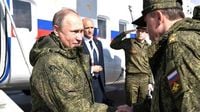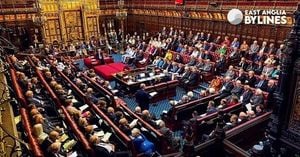Russian and Belarusian forces wrapped up their highly anticipated Zapad-2025 military exercises this week, a sprawling display of military might that drew the wary gaze of NATO, rattled nerves across Eastern Europe, and even featured a surprise cameo by American military observers. The drills, which ran from September 12 to 16, 2025, mobilized around 100,000 troops across 41 ranges in Russia and Belarus, according to statements from both Moscow and Minsk. Russian President Vladimir Putin himself, dressed in full military uniform, oversaw the final phase at the Mulino training ground in Russia’s Nizhny Novgorod region, underscoring the event’s symbolic and strategic weight.
The Zapad (meaning “West”) exercises have long been a fixture of Russia’s military calendar, typically held every four years and often interpreted as a barometer of Moscow’s intentions toward its western neighbors. This year’s drills, the first since 2021, unfolded against a backdrop of heightened regional tensions, with the war in Ukraine grinding on and NATO allies on high alert. According to EFE, the Russian Defense Ministry announced on September 17 that troops who participated in the exercises had begun returning to their permanent bases, signaling the official end of the maneuvers.
Putin’s appearance in military regalia was not lost on analysts. The US Institute for the Study of War (ISW), cited by RBC Ukraine, suggested that Putin’s choice of attire was a deliberate signal to NATO countries, particularly those bordering Russia, such as Poland, Norway, the Baltic states, and Finland. “This is likely a message to NATO countries, which the Kremlin has been regularly threatening in recent months,” ISW reported. Defense Minister Andrey Belousov and his deputies joined Putin at the drills, which also included units from the Leningrad and Moscow military districts, the Aerospace and Airborne Forces, Russian fleets, and Belarusian forces as part of the Union State’s combined Regional Grouping of Forces.
Not everyone agreed about the symbolism of Putin’s uniform. Russian military expert Colonel Viktor Baranets, quoted by Voennoe Delo, downplayed the political significance, stating, “There’s nothing deceptive about it. As the Supreme Commander-in-Chief, the president is simply dressed according to military regulations.” Baranets emphasized that Putin’s appearance in various military uniforms—naval, air force, or army—was merely a matter of protocol and not a veiled threat to the West.
The drills themselves were anything but routine. According to Kommersant and Meduza, they incorporated lessons from Russia’s ongoing campaign in Ukraine, focusing heavily on hybrid strikes, mobile artillery tactics, anti-drone warfare, and, notably, planning for the use of non-strategic nuclear deterrence forces. Commanders described these nuclear elements as “strictly defensive and pre-planned.” The exercises also featured a demonstration of Russia’s new Oreshnik intermediate-range missile, which Moscow has pledged to deploy in Belarus, and the launch of the Zirkon supersonic navy missile from a frigate in the Barents Sea on September 14.
The list of participants extended beyond Russia and Belarus. Soldiers from India, Iran, Bangladesh, Burkina Faso, Congo, and Mali joined the drills, according to Russian news agencies. President Putin later met with military representatives from these countries, a move that seemed to underscore Moscow’s efforts to cultivate military partnerships beyond its traditional sphere of influence.
One of the most unexpected twists came with the presence of American military observers. Invited by Belarus, which has sought closer ties with Washington this year, two U.S. representatives were given “the best places” on the viewing platform, according to The New York Times. The Belarusian Defense Ministry described their attendance as a surprise, writing, “Who would have thought [this would be] how the morning of another day of the Zapad-2025 exercise would begin?” The U.S. later confirmed the invitation, citing recent productive bilateral engagements between the two countries.
Yet, the drills were anything but reassuring for NATO and its neighbors. Just days before the exercises began, around 20 Russian drones violated Polish airspace during an attack on Ukraine. According to EFE, NATO Secretary-General Mark Rutte called it “the largest concentration of violations of NATO airspace that we have seen.” Poland, a frontline NATO member, denounced the incursions as an “act of aggression.” In the wake of the incident, NATO scrambled fighter jets, several of which shot down the drones. Poland, Latvia, and Lithuania responded by closing airspace along their eastern borders, and Poland went so far as to close its land border with Belarus indefinitely during the drills. Romania, too, reported a Russian drone breaching its airspace, becoming the second NATO country in four days to experience such a violation.
These provocations prompted NATO to launch a new initiative, “Eastern Sentinel,” aimed at strengthening the alliance’s eastern defenses. According to Rutte, the operation will involve forces and assets from Denmark, France, the United Kingdom, Germany, and other member states. “The aim is to ensure deterrence and rapid response capabilities along the Alliance’s most exposed flank,” he said. In Poland, Prime Minister Donald Tusk announced that 40,000 troops would be stationed near the Belarus border for the duration of the drills, reflecting the country’s heightened sense of vulnerability. Tusk also claimed that the exercises simulated an occupation of the Suwalki corridor, a strategically vital stretch of land linking Poland and Lithuania—a scenario that has long haunted NATO planners.
While official rhetoric from Moscow framed Zapad-2025 as a defensive operation—“The goal of the Zapad maneuvers is the defense of sovereignty, territorial integrity, and the protection of the Union State of Russia and Belarus against any aggression,” Putin declared—Western analysts and regional leaders saw a clear effort to maintain pressure on NATO and Ukraine. The drills’ timing and scale inevitably drew comparisons to Zapad-2021, which was held just months before Russia’s full-scale invasion of Ukraine.
Not all Russian observers were impressed. According to the Telegram channel Mozhem Obyasnit, cited by Meduza, some pro-war bloggers criticized the exercises as a “circus show” reliant on “long-obsolete tactics and [were] ill-suited to modern war.” The lack of footage of the new Oreshnik missile and the use of free-falling bombs from low and medium altitudes were singled out for mockery. The pro-war account Two Majors quipped that such tactics “would be relevant today only if you were attacking Indians and fighting cowboys.”
As the dust settles on Zapad-2025, the message—intended or not—seems clear: Russia and Belarus are prepared to flex their military muscle, and NATO is taking no chances. The presence of American observers, the deployment of new weaponry, and the unprecedented airspace violations all point to a region on edge. Whether Zapad-2025 will be remembered as a show of strength, a warning shot, or just another round in the long-running standoff between East and West remains to be seen.





